We may earn a commission if you make a purchase through the links on our website.
Best Open-Source Network Monitoring Software and Tools (FREE!)
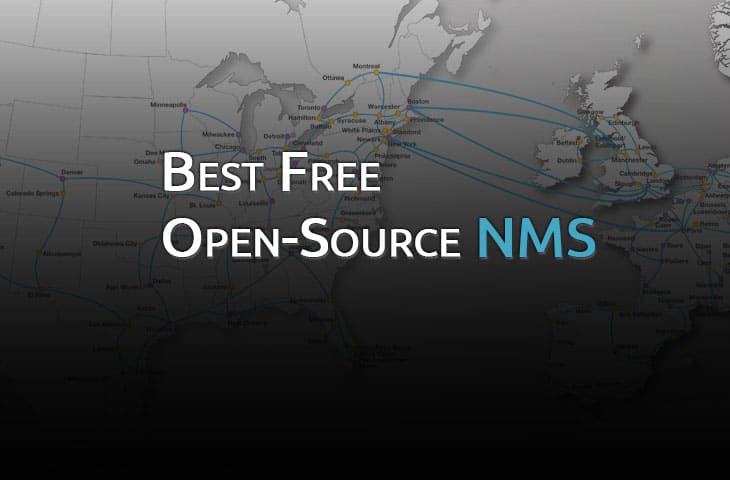
UPDATED: November 25, 2024
Network Monitoring Software covers a surprisingly wide gambit of software and functionality.
Here is our list of the five best free open source network monitoring software and tools:
- Zabbix – EDITOR'S CHOICE A free system monitoring package that includes network, server, application, services, and cloud platform monitoring capabilities. This system uses SNMP and ICMP to discover all devices and continuously monitor their availability and performance. Runs on Linux.
- Observium This free network monitor saves time by squeezing many system graphs of live data into each view and has detailed view overlays to allow greater scrutiny. Installs on Linux.
- Cacti An SNMP-based free network performance monitor that also displays live traffic data in graphs. Runs on Linux.
- Nagios Core A comprehensive & free open source monitoring package that includes network device and traffic monitoring. This system can be expanded by hundreds of free plug-ins. Runs on Linux or on Windows over a VM.
- Icinga 2 This is a fork of Nagios Core and it can take all of the Nagios plug-ins. Offers network performance monitoring and traffic analysis. Runs on Linux.
Some tools are focused purely on observation and tracking of monitoring network traffic, while others are more geared towards response and awareness, with features that let you set alarms or even trigger scripts based on specific events. Other pieces of software allow you to focus on the trends of traffic and network performance for sake of longer term adjustments and heuristics for hardware devices.
Whatever your needs may be, there's likely a free, open-source option that can perfectly fit the bill.
Every network should have at least one of these tools on hand; whether you're performing in-depth troubleshooting and need a program with powerful data aggregation and graphing abilities to help pinpoint a problem device or application, or if you're tracking the traffic of several physical devices over several different network environments over time to watch for trends in your bandwidth needs or other statistics.
What should you look for in free network monitoring tools?
We reviewed the market for free network monitoring software and analyzed the options based on the following criteria:
- Device discovery routines that continuously search for new equipment
- Automatic network inventory creation system
- Graphical representations of live traffic data
- Performance monitoring with alerts when problems arise
- Traffic monitoring to detect bottlenecks
- Easy-to-use, self-installing package
- Forever free and works well without the necessity for paid extras
With these selection criteria in mind, we have found a selection of very good free network monitoring systems. We made sure to find options for Windows and Linux.
The Best Open-Source Network Monitoring Software:
1. Zabbix
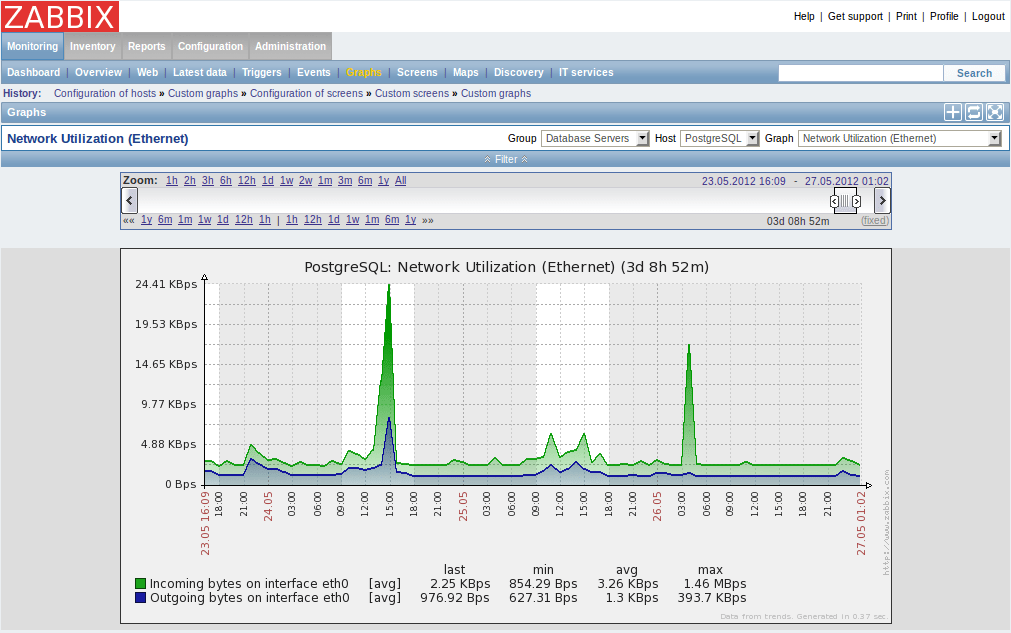
The interesting thing about Zabbix is that there is no enterprise-level paid version, it's all completely open-source and free. They do offer some consulting and monitoring contracts, but the software itself is wide open. It is one of the most powerful open-source options on the market, and can handle most all of the standard NMS needs, plus some.
Key Features:
- Native Graphing: Offers native graphing capabilities for visualizing network performance metrics.
- Wide Cross-Platform Support: Compatible with various operating systems, including Red Hat Enterprise Linux, CentOS, Debian, Oracle Linux, and Ubuntu.
- High Customizability: Meets specific monitoring requirements and preferences.
- Intuitive Interface: Slick and intuitive interface for ease of use and navigation.
- Robust Notification System: Supports SMS, email, custom script, and webhook notifications for timely alerts.
Why do we recommend it?
Zabbix stands out as a powerful open-source network monitoring solution with no enterprise-level paid version, making it accessible to all users without cost. Its wide range of features, including native graphing, extensive cross-platform support, and high customizability, make it one of the most comprehensive options in the realm of network monitoring systems. Zabbix offers a slick and intuitive interface, coupled with ease of installation and compatibility across numerous systems and environments, ensuring a seamless user experience. While it may have some limitations in terms of aggregating and exporting information, its overall performance and feature set make it a valuable asset for organizations seeking robust network monitoring capabilities.
One prime advantage is that it has a particularly slick and intuitive interface, while also being exceptionally easy to install with compatibility across numerous systems and environments. On the flip side, some of its ability to aggregate and report information, and especially then exporting that information, could definitely be a bit stronger in their offering.
Who is it recommended for?
Zabbix is recommended for organizations of all sizes seeking a powerful and cost-effective network monitoring solution. Its open-source nature and lack of a paid version make it particularly appealing for budget-conscious users looking to leverage enterprise-grade features without additional licensing costs. Zabbix's extensive cross-platform support and customizable templates cater to diverse network environments, making it suitable for a wide range of use cases. While it may lack some advanced alerting features, its robust notification system ensures timely alerts via SMS, email, custom script, and webhook, enhancing incident response capabilities.
Pros:
- Open-Source: Transparent tool with no enterprise-level paid version, accessible to all users without cost.
- Broad Monitoring Range: Utilizes both SNMP and ICMP for comprehensive monitoring coverage.
- Real-Time Device Detection: Can detect new devices and configuration changes immediately, ensuring accurate monitoring.
- Useful Templates: Offers useful templates for quick insights into network performance and health.
- Robust Notification System: Features a robust notification system supporting various alerting methods for effective incident response.
Cons:
- Limited Alerting Features: Some users may find the alerting features lacking, particularly in terms of reducing false positives.
Available for Red Hat Enterprise Linux 5, 6 and 7, CentOS, Debian, Oracle Linux and Ubuntu 12.04 and 14.04.
EDITOR'S CHOICE
Zabbix is our top pick for a free, open source network monitoring tool because it has a very appealing interface, which makes it easy to use. The service includes a network discovery process that identifies all devices and maps your network. The monitor makes frequent checks on all devices for statuses, using the SNMP protocol.
Official Site: http://www.zabbix.com/download.php
OS: Linux
2. Observium
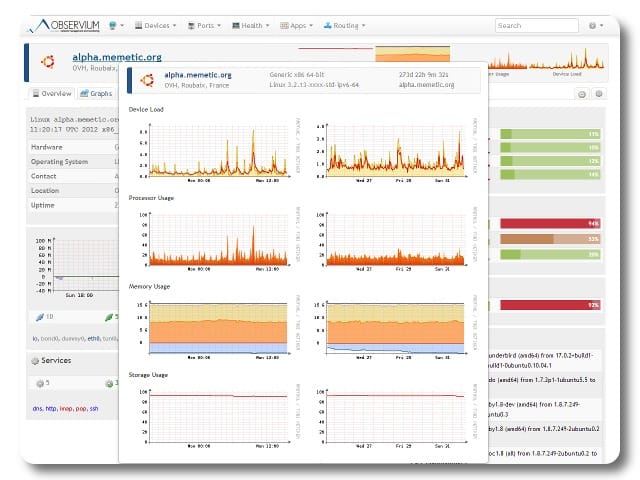
Observium is another offering with a really slick interface style to it. The charts and graphs are all readily available and organized in a beautifully-intuitive fashion. This program pushes more into the realm of physical monitoring of devices and can even show where, geographically, systems are located and how they're communicating and passing traffic!
Key Features:
- Customizable Graphing Widgets: Offers customizable graphing widgets for visualizing network performance metrics.
- Detailed Reporting and Audits: Provides detailed reporting and audits for comprehensive network analysis.
- Support for Professional Version: Offers support for a professional version with additional features and support options.
- Automatic Discovery: Excels in automatic discovery, accurately detecting and mapping network devices for enhanced visibility.
- Native Geolocation Tracking: Supports native geolocation tracking, enabling tracking of global assets and geographical communication patterns.
Why do we recommend it?
Observium stands out as a robust network monitoring solution with a sleek interface and comprehensive features tailored towards physical device monitoring. Its intuitive interface, customizable graphing widgets, and detailed reporting make it a valuable asset for organizations seeking to monitor and manage their network infrastructure effectively. Observium excels in automatic discovery, accurately detecting and mapping network devices while also allowing manual additions for enhanced control. With support for native geolocation tracking, Observium provides valuable insights into the geographical location and communication patterns of network systems, enhancing asset tracking capabilities.
The tool uses a variety of methods for monitoring and does an excellent job of providing automatic discovery while still allowing manual additions. There are few NMS software packages that will do so much of the legwork for you and accurately!
Observium even has a cohesive web interface, meaning you have a lot less to worry about when it comes to accessing controls and viewing network status and statistics from anywhere you are. The software itself is, however, Linux-based aside from the web-based front end. Observium does have a professional edition.
Who is it recommended for?
Observium is recommended for organizations requiring comprehensive network monitoring solutions with a focus on physical device monitoring. Its sleek and easy-to-navigate interface makes it suitable for users of all skill levels, while its support for hardware and traffic monitoring in one solution caters to diverse monitoring needs. While Observium is Linux-based, its cohesive web interface ensures accessibility from anywhere, providing flexibility in monitoring network status and statistics. However, as it is not available for Windows operating systems, organizations utilizing Windows-based environments may need to consider alternative solutions.
Pros:
- Sleek Interface: Sleek and easy-to-navigate interface, suitable for users of all skill levels.
- Comprehensive Monitoring: Supports hardware and traffic monitoring in one solution, catering to diverse monitoring needs.
- Geolocation Tracking: Supports native geolocation tracking, enhancing asset-tracking capabilities.
- Cohesive Web Interface: Provides a cohesive web interface for easy access to controls and network statistics from anywhere.
- Professional Edition: Offers a professional edition with additional features and support options for organizations with specific requirements.
Cons:
- Limited OS Support: Not available for Windows operating systems, limiting compatibility for organizations utilizing Windows-based environments.
Available for Linx/Unix including Debian, RHEL, Ubuntu, CentOS 6 and 7.
Download Link: http://www.observium.org/docs/
3. Cacti
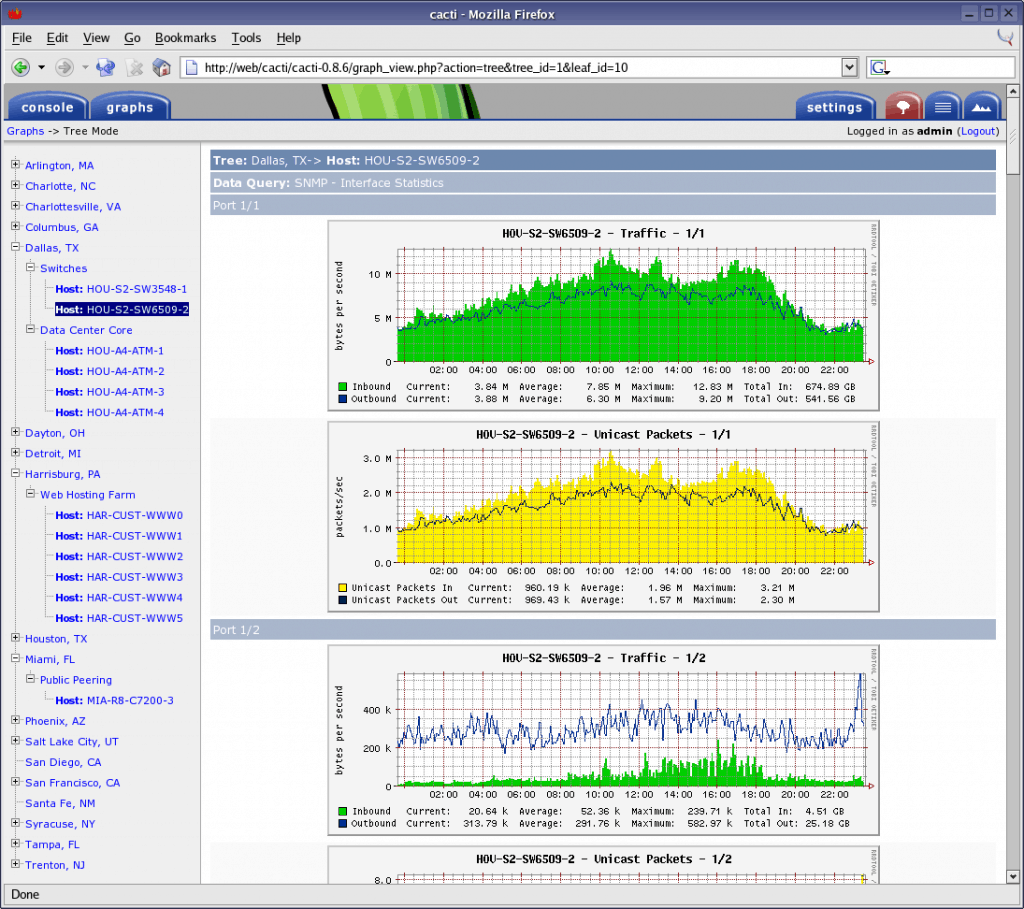
Cacti is a little more particular in its purpose, and slightly more restricted – it does require a MySQL back end database and SNMP has to be installed and configured on agent devices for full functionality, in addition to Cacti itself requiring a PHP/Apache backbone.
Key Features:
- Wide Range of Integrations: Supports a wide range of integrations, allowing users to aggregate data from diverse sources.
- Highly Customizable: Offers extensive customization options for data visualization and presentation.
- Powerful Data Processing: Excels in data aggregation, filtering, and processing, enabling detailed trend tracking and analysis.
- Focus on Data Visualization: Primarily focuses on graphical representations of data sets, ideal for organizations and researchers requiring flexible data visualization solutions.
Why do we recommend it?
Cacti is a highly recommended monitoring tool known for its powerful yet straightforward approach to data aggregation and visualization. While it may have specific requirements, such as a MySQL backend database and SNMP configuration on agent devices, Cacti offers unparalleled flexibility in integrating data sources and customizing visualizations. Its ability to aggregate, filter, and process data makes it ideal for organizations seeking detailed trend tracking and graphical representations of diverse data sets. Despite its requirements, Cacti's simplicity and extensive customization options make it a valuable asset for researchers and organizations looking for flexible data collection and visualization solutions.
Despite being an extremely powerful tool, it is also simple. It takes data, aggregates it, and presents it in just about any way or combination you can possibly want or imagine. If there's any need to see several sets of data side by side, to manipulate them, to draw in data from several other metrics that normally wouldn't even be relevant, Cacti can do it all. It's a tool that focuses primarily, if not almost exclusively, on trend tracking and graphical representations of data sets.
Who is it recommended for?
Cacti is recommended for organizations and researchers seeking a highly customizable monitoring solution with a focus on data visualization. Its wide range of integrations and powerful data processing capabilities cater to diverse monitoring needs, allowing users to manipulate and present data in various ways. While it may have a steeper learning curve compared to competing products, Cacti's dedicated community of over 20,000 members provides valuable support and resources for users seeking to maximize its capabilities. Available for Windows and various Linux/Unix variations, Cacti is suitable for organizations across different operating environments.
Pros:
- Highly Customizable: Offers a highly customizable monitoring solution with a focus on data visualization.
- Large Community Support: Benefits from a large dedicated community of over 20,000 members, providing valuable support and resources.
- Simple Interface: Features a simple interface, making it accessible to users of all skill levels.
- Ideal for Researchers: Ideal for researchers seeking flexibility in data collection and visualization for in-depth analysis.
Cons:
- Steep Learning Curve: Has a steeper learning curve compared to competing products, requiring time and effort to master its capabilities.
Available for Windows, Linux/Unix variations (Gentoo, Debian, Fedora and SUSE).
Download Link: http://www.cacti.net/download_cacti.php
4. Nagios
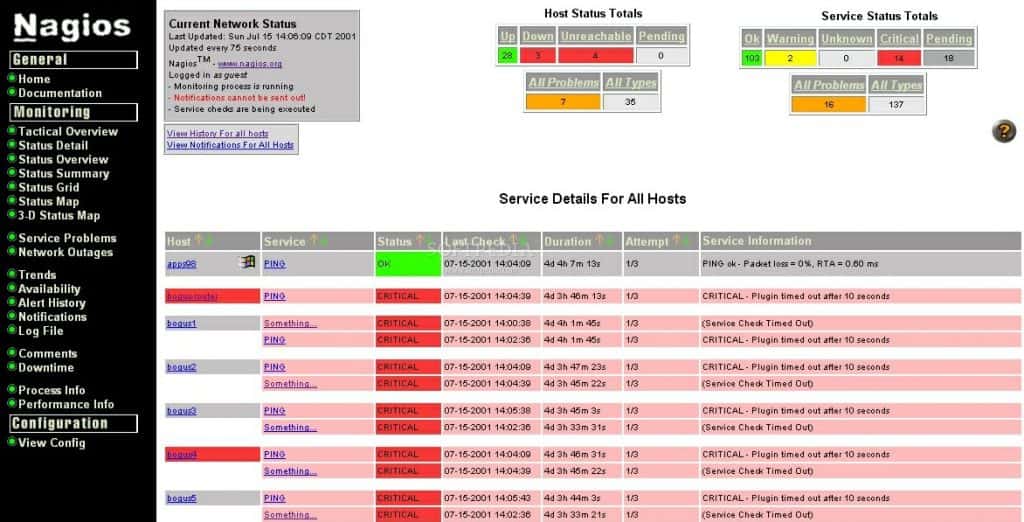
Nagios is one of those programs that is an absolute rose but definitely has its thorns. It's older software, meaning it's tried and true – it's extremely fast and incredibly reliable, but the learning curve for newcomers can easily be prohibitive.
Key Features:
- Multi-Tenant Support: Offers multi-tenant support for managing multiple users and environments.
- Lightweight Installation: Features a lightweight installation process, minimizing resource usage and system overhead.
- Integration with Other Nagios Products: Seamlessly integrates with other Nagios products, providing a comprehensive monitoring solution.
- Flexibility: Provides extensive flexibility in tracking, monitoring, and analyzing network data, catering to diverse monitoring needs.
Why do we recommend it?
Nagios earns our recommendation for its unparalleled reliability and robustness in network monitoring. Despite being older software, Nagios has stood the test of time, boasting exceptional speed and reliability in tracking network performance metrics. Its multi-tenant support and lightweight installation process further enhance its appeal, providing users with a scalable and efficient monitoring solution. Additionally, Nagios seamlessly integrates with other Nagios products, offering users a comprehensive monitoring ecosystem. Its flexibility to track and analyze diverse network data sets makes it an indispensable tool for organizations seeking dependable network monitoring capabilities.
It is similar to some other offerings in that it is immensely flexible. Nagios can track, monitor, and follow trends of almost any data that can be gathered from a network environment, and it's that same flexibility and wide-open capabilities that are both its strength and it's main drawback.
Who is it recommended for?
Nagios is ideally suited for users and organizations prioritizing reliability and flexibility in network monitoring. While its learning curve may pose a challenge for newcomers, Nagios's simplicity and informative interface make it accessible to users of varying technical backgrounds. It is particularly recommended for developers and organizations requiring customizable monitoring capabilities, thanks to its robust API backend and flexible alerting options. Moreover, Nagios's reliability and speed make it a trusted choice for businesses of all sizes, from small startups to large enterprises. Whether managing a single environment or overseeing multiple networks, Nagios provides the tools needed to ensure optimal network performance and reliability.
Pros:
- Simple Interface: Features a simple yet informative interface, facilitating ease of use and navigation.
- Flexible Alerting Options: Supports flexible alerting options, including SMS and email, for timely notifications.
- Robust API Backend: Offers a robust API backend, making it suitable for developers who want to integrate custom applications.
- Reliability: Known for its reliability and speed, Nagios is a trusted choice for network monitoring.
Cons:
- Lack of Quality Support in Open-Source Version: The open-source version may lack the quality support found in paid products, requiring users to rely on community resources for assistance.
- Technical Installation: Installation can be technical and complex, requiring users to have a certain level of technical expertise for setup and configuration.
A powerful piece of monitoring software that is not for the faint of heart. If Nagios doesn't fit the bill, check out the best nagios alternatives for other options. Available For RHEL, CentOS and Nagios for Windows using VMWare or Virtual PC virtual machines.
Download link: https://www.nagios.org/downloads/
5. Icinga
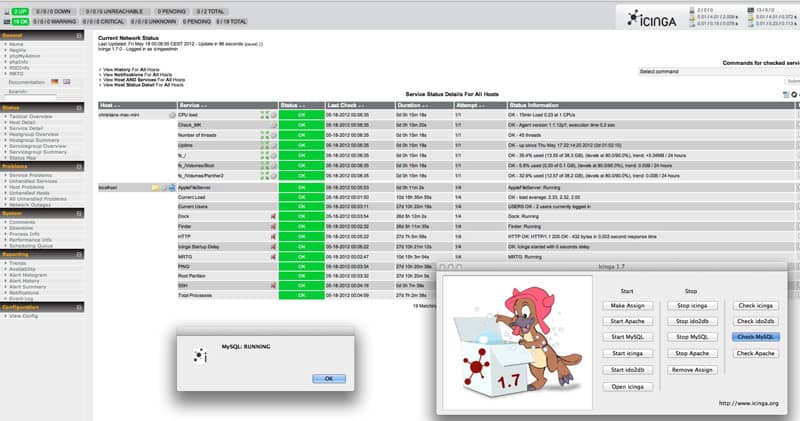
Icinga is a program that gives some of the others, Zabbix especially, a run for its money, but falters when it comes to intuitive setup and configuration. Icinga requires a good wealth of knowledge to know how to get it set up just right, but once you do it's among the best open-source NMS on the market.
Key Features:
- Simple Interface: Offers a user-friendly interface, facilitating ease of navigation and management.
- Wide Platform Support: Supports a wide range of platforms, ensuring compatibility with diverse environments.
- Modular Design: Modular architecture allows for easy extension of functionality through additional modules, enhancing its versatility.
- Visual Reporting: Built-in visual reporting capabilities provide valuable insights into network performance and health.
- Cross-Platform Compatibility: Runs on both Linux and Windows operating systems, catering to various IT environments.
Why do we recommend it?
Icinga stands out as a top contender among open-source NMS options, offering a balance of simplicity and advanced functionality. While its setup and configuration may require a solid understanding of networking principles, once properly configured, Icinga delivers exceptional monitoring capabilities. Its simple interface provides an intuitive user experience, and its support for a wide range of platforms ensures compatibility with diverse environments. Additionally, Icinga's modular design allows for easy extension of functionality through additional modules, making it a versatile solution for various monitoring needs.
Of particular note is the unusual modularity of Icinga – the core software can be installed with just a few small commands, which is the easy part, and from there almost any other functionality, both standard NMS and beyond, can be added one by one. The downside is that each one has to be installed and configured individually, and that coupled with documentation that isn't so great for a quick setup, makes this another powerful tool that's challenging to put to use right away.
Who is it recommended for?
Icinga is recommended for users and administrators seeking a powerful yet customizable monitoring solution. While it may require some technical expertise to set up and configure, Icinga's flexibility and modularity make it suitable for both beginner and experienced users. Administrators who prefer command-line interfaces will appreciate Icinga's ability to be configured via GUI or DSL, offering flexibility in management. Moreover, its support for built-in visual reporting and compatibility with both Linux and Windows operating systems make it a valuable asset for organizations with diverse IT environments. Whether monitoring small networks or large-scale infrastructures, Icinga provides the tools needed to ensure optimal performance and reliability.
Pros:
- Configurability: Can be configured via GUI or DSL, providing flexibility for administrators who prefer CLI tools.
- Built-In Visual Reporting: Supports built-in visual reporting, facilitating data analysis and decision making.
- Modular Architecture: Modular design allows for the addition of custom functionality, keeping the base installation sleek and lightweight.
- Cross-Platform Support: Ability to run on Linux as well as Windows operating systems, ensuring compatibility with diverse IT environments.
Cons:
- Technical Complexity: Setup and configuration may require technical expertise, making it challenging for less experienced users.
- Documentation: May not be sufficient for quick setup and configuration, potentially leading to longer implementation times.
- Designed for Technical Users: Geared towards more technical users, other options may offer better out-of-the-box features for beginners.
Available for Debian, Ubuntu, RHEL/CentOS, openSUSE, SLES, Gentoo, FreeBSD, ArchLinux and Icinga for Windows will require Vagrant and VirtualBox or Parallels Desktop, along with Ruby for Windows installed.
Download link: https://icinga.com/get-started/
Conclusion
Whatever program you choose you can take full advantage of the open-source nature of each, meaning that an attractive price tag of ‘Free' lets you try out all the different software options to see what works best for you and your monitoring needs.
And you can rest easy knowing that the source code is fully available and heavily audited and monitored by the community, which helps reduce security concerns and prevent issues normally present from developer shortsightedness.
Grab one of the above free open-source network monitor tools for Linux or Windows and give it a whirl to see which one works best for you and your needs.
Open Source Network Monitoring Software FAQs
What is the difference between Open-Source Network Monitoring and Commercial Network Monitoring?
Open-Source Network Monitoring and Commercial Network Monitoring differ in terms of cost, features, and support. Open-Source Network Monitoring is free, but may require more time and technical expertise to install and configure, while commercial network monitoring may be more expensive, but typically provides more comprehensive features and support.
How do I get support for an Open-Source Network Monitoring tool?
Support for Open-Source Network Monitoring tools is typically available through online forums, community support, and online documentation. Some open-source network monitoring tools also offer paid support services for users who need more comprehensive assistance.
How do I integrate an Open-Source Network Monitoring tool with my existing network infrastructure?
Integration of an Open-Source Network Monitoring tool with your existing network infrastructure will depend on the specific tool and network infrastructure you are using. Most open-source network monitoring tools offer online documentation, community support, and step-by-step instructions for integration.
Why use Open-Source Network Monitoring?
Open-Source Network Monitoring can offer several benefits, including lower cost, customization options, and community support. Additionally, many open-source network monitoring tools are built on open-source technologies, providing compatibility with other open-source tools.
What are the most popular Open-Source Network Monitoring tools?
Some of the most popular Open-Source Network Monitoring tools include Nagios, Zabbix, Icinga, and Cacti.
What features should I look for in an Open-Source Network Monitoring tool?
When selecting an Open-Source Network Monitoring tool, features to consider include compatibility with your network infrastructure, scalability, alerting capabilities, performance reporting, and ease of use.
Related Articles:
Top 4 Open Source sFlow Collector and Analyzers
13 Free Open Source NetFlow Analyzers for Windows and Linux/Unix